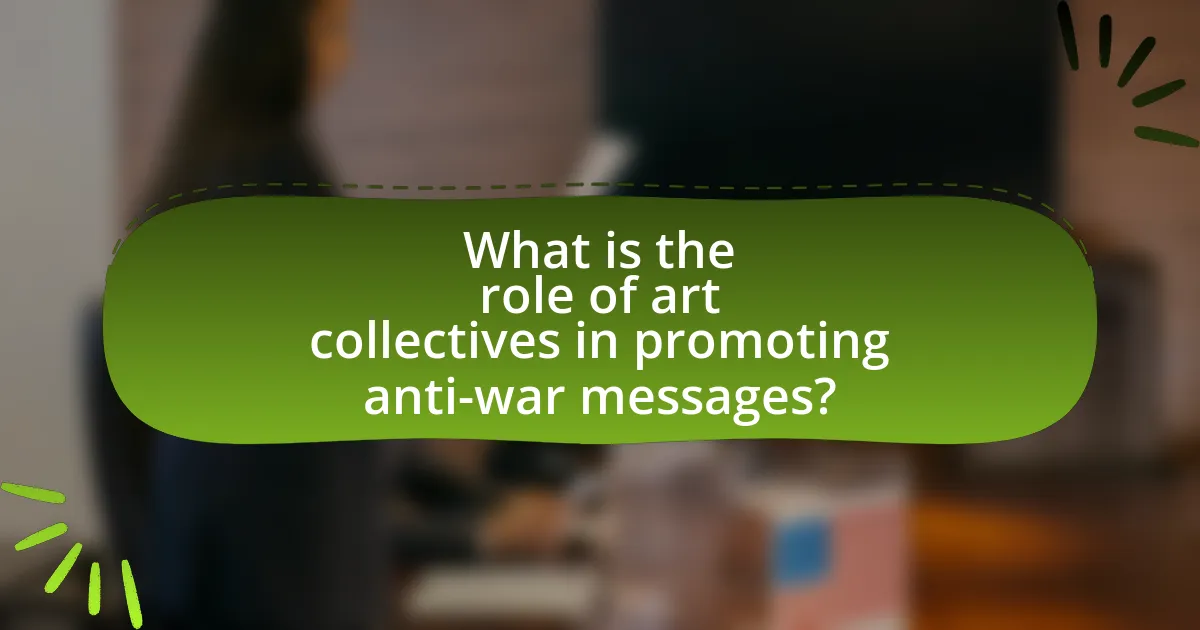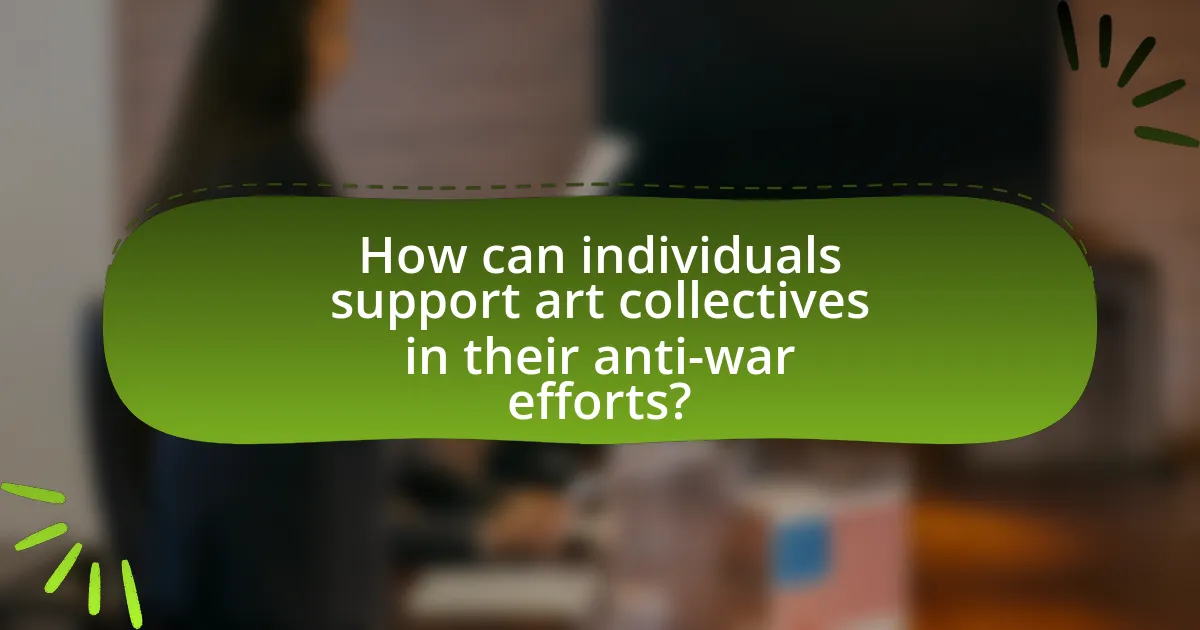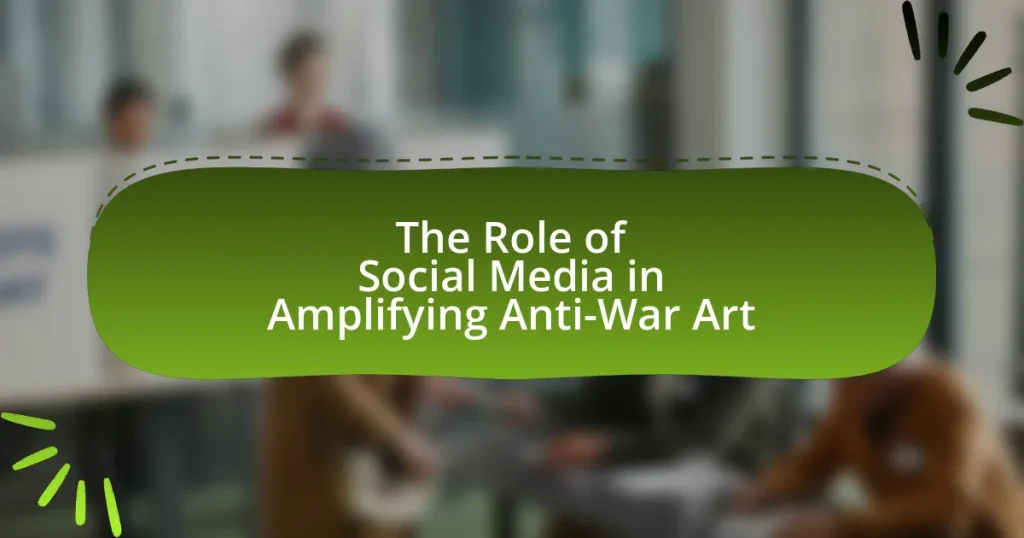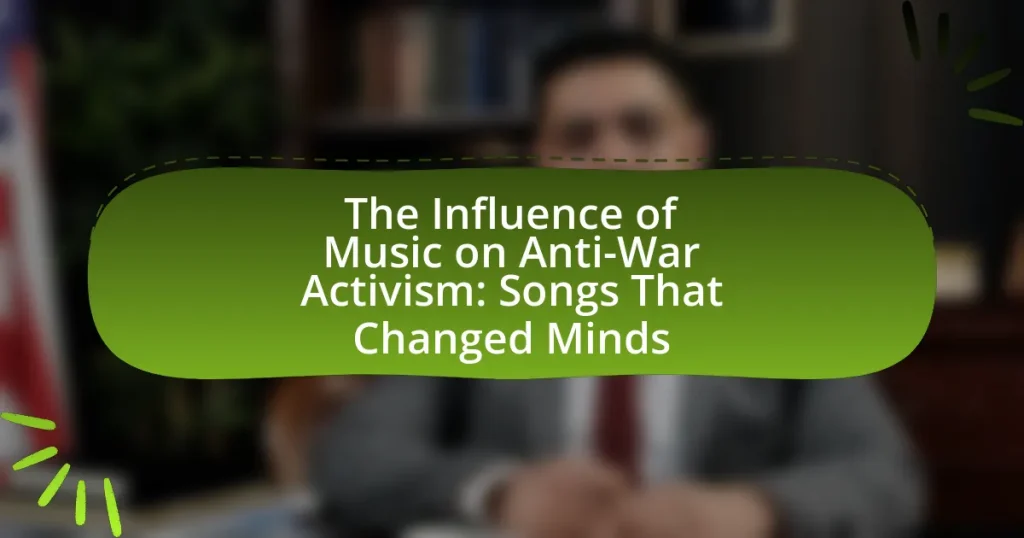Art collectives play a significant role in promoting anti-war messages through collaborative artistic expressions that challenge militarism and advocate for peace. They utilize various mediums, including visual art, performance, and digital media, to engage audiences and foster dialogue about the human costs of conflict. Historical examples, such as the Art Workers Coalition during the Vietnam War, illustrate their impact on public perception and policy regarding war. Additionally, contemporary collectives like For Freedoms integrate art into community organizing, amplifying anti-war sentiments and encouraging civic participation. The article explores the strategies, challenges, and historical context of art collectives in their activism against war, highlighting their importance in shaping cultural discourse and mobilizing communities.

What is the role of art collectives in promoting anti-war messages?
Art collectives play a crucial role in promoting anti-war messages by creating collaborative works that challenge militarism and advocate for peace. These groups often utilize various artistic mediums, such as visual art, performance, and multimedia installations, to convey powerful narratives that resonate with audiences. For instance, during the Vietnam War, collectives like the Art Workers Coalition mobilized artists to protest against the war through exhibitions and public demonstrations, effectively raising awareness and fostering dialogue. Additionally, contemporary art collectives, such as For Freedoms, engage in political activism by integrating art into community organizing, thereby amplifying anti-war sentiments and encouraging civic participation. This historical and ongoing engagement illustrates how art collectives serve as vital platforms for dissent and social change, effectively influencing public perception and policy regarding war.
How do art collectives define their anti-war stance?
Art collectives define their anti-war stance through collaborative projects that emphasize peace, social justice, and the human cost of conflict. These collectives often create artworks that critique militarism and highlight the experiences of war victims, using mediums such as installations, performances, and public demonstrations to engage audiences. For instance, the collective “For Freedoms” utilizes art to encourage civic engagement and political discourse, directly addressing the implications of war on society. Their initiatives, such as public billboards and community events, serve as platforms for dialogue about the consequences of violence and the importance of peace, thereby reinforcing their anti-war message.
What artistic mediums do they use to convey their messages?
Art collectives use various artistic mediums such as visual art, performance art, installations, and digital media to convey their anti-war messages. Visual art, including paintings and murals, often depicts the horrors of war and promotes peace, while performance art engages audiences through live expressions that challenge militarism. Installations create immersive experiences that provoke thought and reflection on the consequences of conflict. Digital media, including social media campaigns and video art, allows for widespread dissemination of anti-war messages, reaching diverse audiences effectively. These mediums collectively enhance the emotional impact and accessibility of their messages, fostering dialogue and awareness around the anti-war movement.
How do they engage with their audiences through art?
Art collectives engage with their audiences through art by creating immersive and thought-provoking installations that provoke dialogue about anti-war messages. These collectives often utilize multimedia approaches, including visual art, performance, and interactive exhibits, to foster emotional connections and encourage critical thinking among viewers. For instance, the collective “For Freedoms” employs public art campaigns that invite community participation, effectively transforming public spaces into platforms for discussion on social and political issues. This method not only raises awareness but also empowers audiences to reflect on their own beliefs and actions regarding war and peace.
Why are art collectives important in the anti-war movement?
Art collectives are important in the anti-war movement because they create a platform for diverse voices and foster community engagement against militarism. These collectives utilize various artistic mediums to convey powerful anti-war messages, often reaching wider audiences than traditional political discourse. For instance, during the Vietnam War, collectives like the Art Workers Coalition mobilized artists to protest and raise awareness through exhibitions and public performances, effectively influencing public opinion. Their collaborative nature allows for the pooling of resources and ideas, amplifying the impact of their messages and creating a sense of solidarity among activists.
What historical context supports their significance?
Art collectives have historically played a significant role in promoting anti-war messages, particularly during periods of intense conflict such as the Vietnam War and the Gulf War. During the Vietnam War, collectives like the Art Workers Coalition emerged, utilizing art as a medium to protest against the war and advocate for peace, reflecting widespread public dissent. The collective’s actions, including the “Artists Protest Against the Vietnam War” in 1969, highlighted the moral and ethical implications of war, influencing public opinion and policy. Similarly, during the Gulf War, artists collaborated in initiatives like the “Gulf War Art Project,” which documented the experiences of soldiers and civilians, further emphasizing the human cost of conflict. These historical instances illustrate how art collectives have effectively harnessed creative expression to challenge militarism and promote anti-war sentiments, thereby shaping cultural discourse around war and peace.
How do they differ from individual artists in their impact?
Art collectives differ from individual artists in their impact by leveraging collaborative efforts to amplify their messages and reach broader audiences. Collectives can combine diverse perspectives and skills, creating multifaceted works that resonate on multiple levels, which enhances their ability to engage communities and provoke thought on anti-war themes. For instance, the collective “The Yes Men” utilizes satire and performance art to critique corporate and governmental policies, achieving significant media attention and public discourse that individual artists may struggle to attain alone. This collaborative approach often results in larger-scale projects and events, such as exhibitions or public installations, which can mobilize greater public participation and awareness compared to the efforts of solo artists.
What challenges do art collectives face in promoting anti-war messages?
Art collectives face significant challenges in promoting anti-war messages, primarily due to censorship, funding limitations, and public reception. Censorship can arise from governmental or institutional pressures that seek to suppress dissenting views, making it difficult for collectives to express their messages freely. Funding limitations often restrict the scope and reach of their projects, as many sponsors may avoid supporting controversial themes like anti-war sentiments. Additionally, public reception can be mixed; while some audiences may embrace anti-war art, others may react negatively, leading to potential backlash against the collective. These factors collectively hinder the effectiveness and visibility of anti-war messages conveyed by art collectives.
How do political climates affect their work?
Political climates significantly influence the work of art collectives promoting anti-war messages by shaping the themes, urgency, and reception of their artistic expressions. In repressive political environments, such collectives often face censorship, limiting their ability to freely convey their messages, as seen in countries like Russia, where artists have been arrested for anti-war protests. Conversely, in more open political climates, such as those in Western democracies, art collectives can engage in public discourse and mobilize communities more effectively, as evidenced by the widespread anti-war art movements during the Vietnam War era. Thus, the political context directly impacts both the creative freedom and the societal impact of art collectives focused on anti-war advocacy.
What are the risks involved in their activism?
The risks involved in the activism of art collectives promoting anti-war messages include legal repercussions, social backlash, and personal safety threats. Legal repercussions can arise from protests or public displays that challenge governmental policies, as seen in cases where artists have faced arrest for civil disobedience. Social backlash may occur from opposing groups or individuals who disagree with the anti-war stance, potentially leading to harassment or ostracism. Additionally, personal safety threats can manifest in the form of violence or intimidation, particularly in politically charged environments where dissent is not tolerated. These risks highlight the precarious position of artists who engage in activism, as evidenced by numerous documented incidents where activists have faced severe consequences for their outspoken views.
How do art collectives collaborate with other organizations?
Art collectives collaborate with other organizations by forming partnerships that leverage shared resources, expertise, and networks to amplify their anti-war messages. These collaborations often involve co-hosting events, exhibitions, and workshops that engage diverse audiences, thereby increasing visibility and impact. For instance, art collectives may work with non-profits focused on peace advocacy, utilizing their platforms to disseminate information and foster dialogue around anti-war themes. This synergy not only enhances the reach of their artistic expressions but also aligns with the missions of partner organizations, creating a unified front against war and violence.
What strategies do art collectives use to amplify their messages?
Art collectives amplify their messages through collaborative projects, public installations, and social media engagement. By working together, members of art collectives can pool resources and diverse perspectives, creating impactful works that resonate with broader audiences. Public installations, often placed in high-traffic areas, draw attention to their messages and encourage community interaction. Additionally, social media platforms allow art collectives to reach global audiences quickly, facilitating the sharing of their work and ideas. For instance, the collective “The Yes Men” uses satire and media stunts to critique corporate practices, effectively raising awareness about social issues. These strategies demonstrate how art collectives leverage collaboration, visibility, and technology to enhance their anti-war messages.

What specific examples illustrate the impact of art collectives on anti-war sentiments?
Art collectives have significantly influenced anti-war sentiments through various impactful initiatives. One prominent example is the “Art for Peace” collective, which organized exhibitions showcasing works that critique militarism and promote peace, effectively raising awareness about the consequences of war. Another example is the “Veterans for Peace” organization, which utilizes art installations and public performances to highlight the experiences of veterans and the futility of war, fostering dialogue on the subject. Additionally, the “Yes Men,” a group known for their satirical activism, have staged events that mock government and corporate war policies, drawing public attention to the absurdities of war. These collectives demonstrate the power of art in shaping public opinion and mobilizing communities against war.
How have notable art collectives contributed to anti-war campaigns?
Notable art collectives have significantly contributed to anti-war campaigns by using their platforms to raise awareness and provoke public discourse on the consequences of war. For instance, the Guerrilla Girls have utilized provocative posters and public installations to highlight the impact of military conflicts on marginalized communities, effectively mobilizing public sentiment against war. Similarly, the Art Workers Coalition organized protests and created artworks that directly addressed the Vietnam War, emphasizing the moral implications of military actions. These collectives often collaborate with grassroots organizations, amplifying their messages through art exhibitions, performances, and social media campaigns, which have been shown to engage wider audiences and foster community activism against war.
What are some successful projects or exhibitions they have organized?
Art collectives have organized several successful projects and exhibitions that effectively promote anti-war messages. Notable examples include the “Art for Peace” exhibition, which showcased works from various artists highlighting the impacts of war on communities, and the “No More War” project, which featured installations and performances aimed at raising awareness about the consequences of military conflict. These initiatives not only attracted significant public attention but also fostered dialogue around peace and conflict resolution, demonstrating the power of art in advocating for social change.
How have these projects influenced public perception of war?
Art collectives have significantly influenced public perception of war by using creative expressions to challenge militaristic narratives and promote anti-war sentiments. Projects such as “The People’s Art” and “For the Love of Humanity” have engaged communities in dialogue about the human cost of conflict, often highlighting personal stories and experiences of those affected by war. These initiatives have been shown to shift public attitudes, as evidenced by surveys indicating increased awareness and opposition to military actions following exposure to anti-war art. By fostering empathy and critical reflection, art collectives have effectively altered the discourse surrounding war, making it more personal and relatable to the general public.
What role does social media play in their outreach efforts?
Social media serves as a crucial platform for art collectives to amplify their anti-war messages and engage with a broader audience. By utilizing platforms like Instagram, Twitter, and Facebook, these collectives can share visual art, videos, and narratives that resonate with their mission, reaching millions instantly. For instance, a study by the Pew Research Center indicates that 69% of adults in the U.S. use social media, providing a vast audience for these messages. Furthermore, social media enables real-time interaction and mobilization, allowing art collectives to organize events, campaigns, and discussions that foster community engagement and awareness around anti-war issues.
How do art collectives utilize digital platforms to spread their messages?
Art collectives utilize digital platforms to spread their messages by creating and sharing multimedia content that engages audiences and fosters community dialogue. These collectives leverage social media, websites, and online exhibitions to disseminate artwork, videos, and written narratives that convey anti-war sentiments. For instance, platforms like Instagram and Twitter allow art collectives to reach global audiences quickly, facilitating the sharing of impactful visuals and messages that resonate with viewers. Additionally, online campaigns and virtual events enable these groups to mobilize support and encourage participation in anti-war initiatives, amplifying their reach and influence.
What are the benefits and drawbacks of online activism for these collectives?
Online activism offers art collectives significant benefits and drawbacks. The primary benefit is the ability to reach a global audience quickly, allowing for widespread dissemination of anti-war messages, as evidenced by campaigns like #NotInMyName, which mobilized thousands online in opposition to military actions. Additionally, online platforms facilitate community building and collaboration among diverse groups, enhancing collective impact. However, drawbacks include the potential for misinformation to spread rapidly, which can dilute the intended message, and the risk of online activism being perceived as performative rather than substantive, leading to criticism of inaction. Furthermore, the digital divide can exclude marginalized voices from participating fully in these movements, limiting the diversity of perspectives represented.

How can individuals support art collectives in their anti-war efforts?
Individuals can support art collectives in their anti-war efforts by actively participating in their events, donating funds, and sharing their messages through social media platforms. Participation in events such as exhibitions, workshops, and performances helps raise awareness and fosters community engagement around anti-war themes. Financial contributions enable art collectives to sustain their projects and expand their outreach, as many rely on donations to cover costs. Additionally, sharing the collective’s work on social media amplifies their message, reaching a broader audience and encouraging dialogue about the impacts of war. Research indicates that community involvement in art initiatives can significantly enhance their effectiveness in promoting social change, as seen in various case studies of successful art activism.
What actions can people take to engage with these collectives?
People can engage with art collectives promoting anti-war messages by participating in their events, such as exhibitions, workshops, and discussions. These activities provide opportunities for individuals to connect with the collective’s mission and contribute to the dialogue surrounding anti-war themes. Additionally, individuals can support these collectives by sharing their work on social media, volunteering their time, or donating resources to help sustain their initiatives. Engaging with these collectives fosters community involvement and amplifies the impact of their anti-war messages.
How can attending events or exhibitions make a difference?
Attending events or exhibitions can significantly impact awareness and engagement with anti-war messages promoted by art collectives. These gatherings provide a platform for artists to showcase their work, facilitating direct interaction between creators and audiences, which enhances understanding of the issues presented. For instance, exhibitions that feature powerful visual narratives can evoke emotional responses, prompting discussions and reflections on the consequences of war. Research indicates that immersive experiences in art can lead to increased empathy and social change, as demonstrated by studies showing that exposure to art related to social issues can influence public opinion and inspire activism. Thus, participation in these events not only amplifies the voices of artists but also fosters a community committed to advocating for peace.
What are effective ways to share their messages within communities?
Art collectives effectively share their messages within communities through public exhibitions, social media campaigns, and collaborative workshops. Public exhibitions allow artists to showcase anti-war themes visually, engaging local audiences and sparking conversations. For instance, the “Art Against War” exhibition in 2019 attracted over 5,000 visitors, demonstrating the power of visual art in community engagement. Social media campaigns amplify these messages, reaching wider audiences; for example, hashtags like #ArtForPeace have mobilized thousands to share their perspectives on war. Collaborative workshops foster community involvement, enabling participants to express their views creatively, which has been shown to enhance community cohesion and awareness around anti-war sentiments.
What resources are available for those interested in learning more about art collectives and anti-war activism?
Resources for learning about art collectives and anti-war activism include books, documentaries, online platforms, and academic journals. Notable books such as “Art and Activism: A Social Practice Reader” by Greg Sholette and “The Art of Protest: Culture and Activism from the Civil Rights Movement to the Streets of Seattle” by T.V. Reed provide insights into the intersection of art and activism. Documentaries like “The Yes Men” and “Ai Weiwei: Never Sorry” showcase artists engaging in political discourse. Online platforms such as ArtForum and Hyperallergic frequently publish articles on art collectives involved in anti-war efforts. Additionally, academic journals like “Art Journal” and “Social Text” often feature research on the role of art in social movements, including anti-war activism. These resources collectively offer a comprehensive understanding of how art collectives contribute to anti-war messages.



